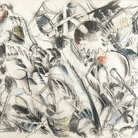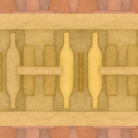How Much Is Too Much?

How Much Is Too Much?
Dal 28 September 2017 al 31 January 2018
Venezia
Luogo: A plus A gallery
Indirizzo: San Marco 3073
Orari: Mar - Dom 11 - 18
Costo del biglietto: Ingresso libero
Telefono per informazioni: +39 041 2770466
E-Mail info: info@aplusa.it
Sito ufficiale: http://www.aplusa.it
In a society that is constantly looking for
more, we often find ourselves thinking, how
much is too much?
The School for Curatorial Studies Venice presents “How Much Is Too Much?” opening on 28 September at 18.00 in A Plus A Gallery.
Curated by 21 international students from The School for Curatorial Studies Venice, including works by:
Amelia Crouch (UK) | Oliver Czarnetta (GER) | Sam Ekwurtzel (USA) | Daniel Faust (USA) | Benjamin Hirte (AT) | Paloma Muñoz & Walter Martin (USA) | Rohwajeong (South Korea) | Giles Round (UK) | Vanessa Safavi (CH) | Aki Sasamoto (JAP)
In Invisible Cities, Italo Calvino describes the “continuous city” of Leonia, where “every morning the people wake between fresh sheets, wash with just-unwrapped cakes of soap, wear brand-new clothing, and listen to the last-minute jingles from the most up-to-date radio.” Though 45 years have passed, Leonia evokes a familiar image for us today. Global cities are overwhelmed with the seemingly endless amount of things to do and see, not to mention products to consume. With this ambush of physical and emotional stimuli, we cannot help but wonder how contemporary society is able to sift through it all. How do we filter through abundance and store our selections? In a society constantly looking for more, we often find ourselves thinking, How Much is Too Much?
Confronted with excess, our instinctive reaction is to organize and compartmentalize our thoughts and experiences. On the one hand, this can serve as an effective coping mechanism to deal with topics we are not ready to address. On the other, it can function as a form of denial or stigmatization. We accumulate and expel, putting things aside to deal with them later, but more often than not we forget what we have put away in the first place. What do our discarded experiences, interactions, thoughts, and objects say about us? How does compartmentalizing as an attempt to manage excess affect our psyche, perception, and overall society? Are we missing something when we try to organize, classify, and fit everything into certain structures?
Addressing the urgency in these questions, How Much is Too Much? welcomes visitors on an immersive journey to discover the substance of our sensory archives only to pause and reflect upon the impact of our habits of compartmentalization.
Following A Plus A Gallery’s long history of collective curatorial projects, How Much is Too Much? aims to create an environment of critical reflection for both artist and viewer alike. The exhibition takes the overwhelming excess of contemporary society as its starting point, opening with Giles Round’s playful pieces that encroach upon the very walls they inhabit and thus reference the sensory overload and high-speed dissemination of popular culture, Benjamin Hirte’s minimal reflections on how our behavior is organized by commercial branding and familiar visual cues, and Vanessa Safavi’s more subdued explorations of interiority and all that is hidden. Teased with these expressions of excess and internality, viewers will then make their way to a unique compartmentalized display of works by Amelia Crouch, Oliver Czarnetta, Sam Ekwurtzel, Daniel Faust, Paloma Muñoz & Walter Martin, Rohwajeong, and Aki Sasamoto, all of whose practices explore the many methods and consequences of how we deal with the muchness around us. Bringing these artists together using experimental modes of display, How Much is Too Much? presents a wide range of new and existing works to shed light on an increasingly pressing issue of our time. Instead of allowing our compartments to pile up and push further out, teetering on the edge of a landslide, let us examine the contents of what we have sealed away.
Major support for the exhibition is provided by RAJAPACK and our long time partners We Exhibit and Drusian.
SCARICA IL COMUNICATO IN PDF
vanessa safavi
·
oliver czarnetta
·
a plus a gallery
·
daniel faust
·
benjamin hirte
·
amelia crouch
·
sam ekwurtzel
·
rohwajeong
·
giles round
·
vanessa safavi e aki sasamoto
·
aki sasamoto
·
COMMENTI

-
 Dal 20 December 2025 al 20 April 2026
Caserta | Reggia di Caserta
Dal 20 December 2025 al 20 April 2026
Caserta | Reggia di Caserta
Regine: trame di cultura e diplomazia tra Napoli e l’Europa
-
 Dal 19 December 2025 al 23 March 2026
Torino | Palazzo Madama - Museo Civico d’Arte Antica
Dal 19 December 2025 al 23 March 2026
Torino | Palazzo Madama - Museo Civico d’Arte Antica
Il castello ritrovato. Palazzo Madama dall’età romana al medioevo
-
 Dal 17 December 2025 al 19 January 2026
Roma | Palazzo della Cancelleria
Dal 17 December 2025 al 19 January 2026
Roma | Palazzo della Cancelleria
De Humana Mensura di Linda Karshan
-
 Dal 18 December 2025 al 12 April 2026
Firenze | Gallerie degli Uffizi
Dal 18 December 2025 al 12 April 2026
Firenze | Gallerie degli Uffizi
Cera una volta. Sculture dalle collezioni medicee
-
 Dal 11 December 2025 al 9 April 2026
Firenze | Museo Archeologico Nazionale di Firenze
Dal 11 December 2025 al 9 April 2026
Firenze | Museo Archeologico Nazionale di Firenze
Icone di Potere e Bellezza
-
 Dal 11 December 2025 al 11 January 2026
Roma | Palazzo Esposizioni Roma
Dal 11 December 2025 al 11 January 2026
Roma | Palazzo Esposizioni Roma
Giorgio Morandi nella Collezione Eni. Un viaggio attraverso la storia culturale del cane a sei zampe e l’eredità di Enrico Mattei


